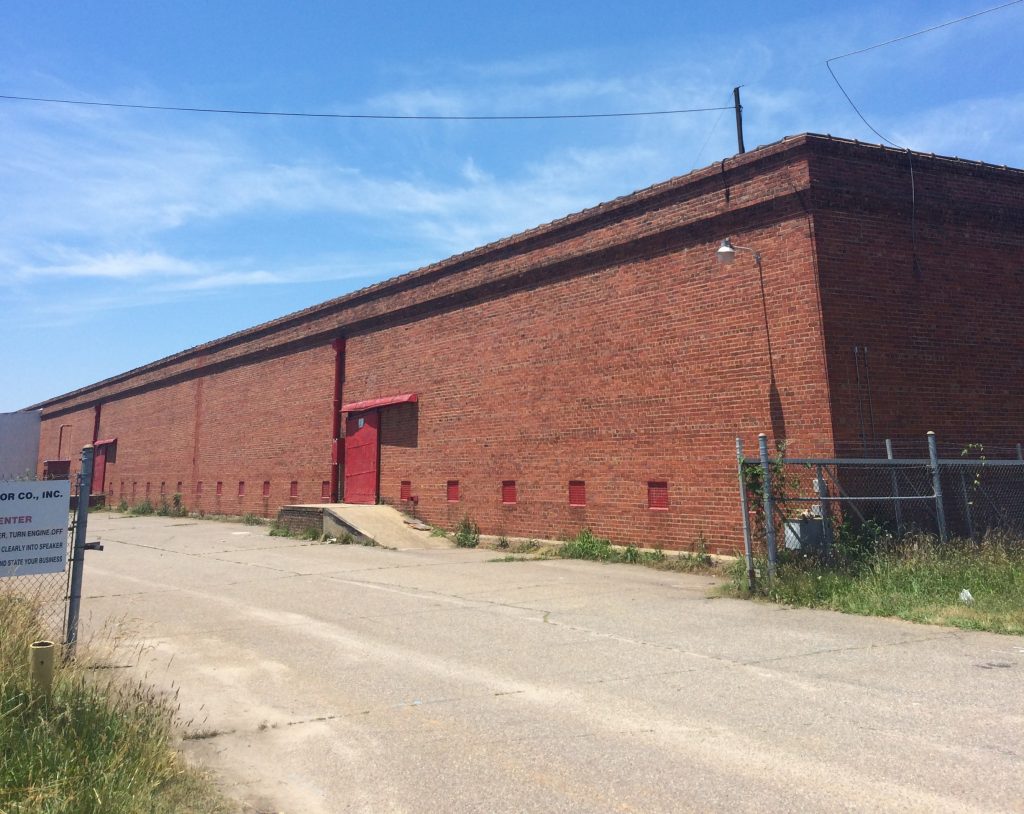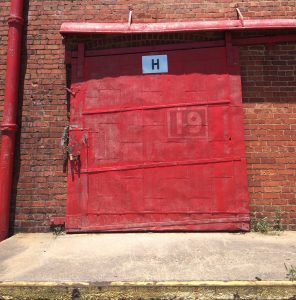
Developers plan to convert the former tobacco warehouse at 1650 Overbrook Road into as many as 117 apartments. (Kieran McQuilkin)
Following several iterations over the course of four years, plans to convert a century-old warehouse near The Diamond into apartments have received city approval.
Historic Housing’s planned Overbrook Lofts, which will convert the former tobacco warehouse at 1650 Overbrook Road into as many as 117 apartments, was approved as part of city council’s consent agenda at its meeting on Monday.
The approval follows months of negotiations with city planners that resulted in the removal of a provision that would have required windows to be cut into the building’s currently windowless south-facing wall after five years.
The provision had been viewed as running counter to the intent of historic tax credit programs that Historic Housing plans to use for the $15 million project. The review period for those programs, which require the wall to be left unaltered, would expire five years after the project is completed.
Since purchasing the property in 2012, Historic Housing – led by developers Louis Salomonsky and David White – had previously proposed cutting windows into the wall for a tax-credit conversion that would have filled the building with 205 units. That proposal was withdrawn in 2014 when it failed to pass muster with the National Park Service.

Negotiations prompted the removal of a provision that would have required windows to be cut into the building’s currently windowless south-facing wall after five years. (Kieran McQuilkin)
Following Monday’s meeting, White expressed relief at securing city council’s approval while keeping the project eligible for the state and federal credits.
“We’re very pleased to be at this point, finally,” he said. “I think everybody’s pleased with this solution.”
White said the goal of the city’s provision was less about rules regarding windowless dwelling units than about a desire from the city for windows facing Overbrook. The building stretches the length of three football fields along the street across from Hardywood Park Craft Brewery.
“That wasn’t possible with the historic tax credit program, so we worked out a compromise that was,” White said.
He said demolition work and structural repairs have started at the building, which he said has suffered from water leaks that had destroyed parts of the roof.
“We’ve been repairing that and taking off some exterior components of the building,” he said. “We are going to start doing the interior of the building and proceeding with the project.”
Construction is expected to last 12 months, with the first units to be delivered by mid-summer next year. The one- and two-bedrooms units will range in size from 700 to 1,200 square feet, and in price from $900 to $1,450 per month.
The builder on the project is Candela Construction, which White described as a successor to Historic Housing’s traditional construction arm, SWA Construction. Salomonsky’s SWA Architects is designing the project, and M&T Bank is providing financing.
Historic Housing also developed the nearby Todd Lofts apartments on Hermitage Road. The developers’ real estate management arm, Main Street Realty, manages those apartments as well as the 1 Scott’s Addition apartments on Summit Avenue.
White and Salomonsky are also behind the Scott’s View towers proposed in Scott’s Addition. That project is near a cluster of buildings that recently sold for a planned office renovation.

Developers plan to convert the former tobacco warehouse at 1650 Overbrook Road into as many as 117 apartments. (Kieran McQuilkin)
Following several iterations over the course of four years, plans to convert a century-old warehouse near The Diamond into apartments have received city approval.
Historic Housing’s planned Overbrook Lofts, which will convert the former tobacco warehouse at 1650 Overbrook Road into as many as 117 apartments, was approved as part of city council’s consent agenda at its meeting on Monday.
The approval follows months of negotiations with city planners that resulted in the removal of a provision that would have required windows to be cut into the building’s currently windowless south-facing wall after five years.
The provision had been viewed as running counter to the intent of historic tax credit programs that Historic Housing plans to use for the $15 million project. The review period for those programs, which require the wall to be left unaltered, would expire five years after the project is completed.
Since purchasing the property in 2012, Historic Housing – led by developers Louis Salomonsky and David White – had previously proposed cutting windows into the wall for a tax-credit conversion that would have filled the building with 205 units. That proposal was withdrawn in 2014 when it failed to pass muster with the National Park Service.

Negotiations prompted the removal of a provision that would have required windows to be cut into the building’s currently windowless south-facing wall after five years. (Kieran McQuilkin)
Following Monday’s meeting, White expressed relief at securing city council’s approval while keeping the project eligible for the state and federal credits.
“We’re very pleased to be at this point, finally,” he said. “I think everybody’s pleased with this solution.”
White said the goal of the city’s provision was less about rules regarding windowless dwelling units than about a desire from the city for windows facing Overbrook. The building stretches the length of three football fields along the street across from Hardywood Park Craft Brewery.
“That wasn’t possible with the historic tax credit program, so we worked out a compromise that was,” White said.
He said demolition work and structural repairs have started at the building, which he said has suffered from water leaks that had destroyed parts of the roof.
“We’ve been repairing that and taking off some exterior components of the building,” he said. “We are going to start doing the interior of the building and proceeding with the project.”
Construction is expected to last 12 months, with the first units to be delivered by mid-summer next year. The one- and two-bedrooms units will range in size from 700 to 1,200 square feet, and in price from $900 to $1,450 per month.
The builder on the project is Candela Construction, which White described as a successor to Historic Housing’s traditional construction arm, SWA Construction. Salomonsky’s SWA Architects is designing the project, and M&T Bank is providing financing.
Historic Housing also developed the nearby Todd Lofts apartments on Hermitage Road. The developers’ real estate management arm, Main Street Realty, manages those apartments as well as the 1 Scott’s Addition apartments on Summit Avenue.
White and Salomonsky are also behind the Scott’s View towers proposed in Scott’s Addition. That project is near a cluster of buildings that recently sold for a planned office renovation.



“That wasn’t possible with the historic tax credit program, so we worked out a compromise that was,” White said.
If they aren’t going to cut windows into that facade, then what *was* the compromise? It seems to be the point of the article, yet it’s never spelled out. Skylights? Interior courtyards? Fake windows on the facade?
Any follow-up would be appreciated.
This project seems like a bad idea. Even if they can give the apartments enough light, it’s going to be really tough to market these because it will look like a pit from the outside.
Too bad this couldn’t have been developed into a theater or church or something for which natural light isn’t a key factor.
Good luck to the developers.
So what’s the deal with the windows? Will they be cut into the south-facing walls from the beginning?
Re: windows, our previous coverage reported the project will include a courtyard with an open-air, Plexiglass-style roof that will provide additional light to units, per state requirements. More on those details here: https://richmondbizsense.com/2016/06/21/warehouse-conversion-plan-returns-with-tax-credits-and-window-debate/
Windowless boxes in a desolate non-neighborhood.